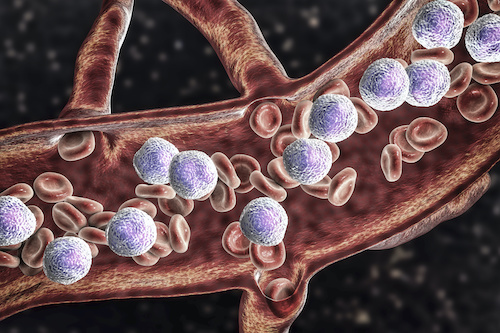
New Brunswick, N.J., December 12, 2021– T-cell acute lymphoblastic leukemia (T-ALL) is an aggressive type of leukemia. Despite advances in treatments, patients have an extremely poor prognosis, highlighting the need to explore the genetic components that lead to the formation of T-ALL, as well as the need to discover new targeted therapeutic approaches and treatment resistance. Researchers from Rutgers Cancer Institute of New Jersey, the state’s only NCI-designated Comprehensive Cancer Center, examined the effects of SIRT1, an enzyme located primarily in the cell nucleus that contributes to cellular regulation on the transformation of T-cells.
Results of the work are being presented in a poster at the American Society of Hematology Annual Meeting later this week, during which other works are being presented by investigators from Rutgers Cancer Institute, RWJBarnabas Health and Robert Wood Johnson University Hospital. Senior author Daniel Herranz Benito, PhD, resident researcher at Rutgers Cancer Institute and assistant professor of Pharmacology at Rutgers Robert Wood Johnson Medical School shares more.
Why is this topic important to explore?
T-ALL is an aggressive hematologic malignancy that affects both children and adults. Nowadays, most cases get cured by using intensive chemotherapy regimens, however, 20 to 50 percent of patients still relapse and, at this point, are refractory to current treatments and ultimately die of their disease. In addition, these regimens also have associated long-term morbidities. Thus, identifying novel therapeutic strategies for the treatment of T-ALL is of the utmost importance.
Tell us about the work and what you and your colleagues found?
Using a variety of in vivo genetic experiments, together with cutting-edge techniques, we have uncovered a very relevant role for the histone deacetylase called SIRT1 in T-ALL and we have demonstrated that targeting SIRT1 results in very significant antileukemic effects in vivo.
What are the implications and next steps related to this work)?
SIRT1 could be explored as a new therapeutic target in patients, alone or in combination with current antileukemic drugs. Next steps would be to develop safe, specific and potent Sirt1 inhibitors that could be tested in patients.
Along with Dr. Herranz, other authors on the work are Olga Lancho, PhD, Amartya Singh, PhD, Victoria da Silva-Diz, PhD, Patricia Renck Nunes, PhD, Luca Tottone, PhD, all Rutgers Cancer Institute; Shirley Luo BSc, Rutgers University and Maya Aleksandrova BSc, Xiaoyang Su, PhD, and Hossein Khiabanian, PhD, all Rutgers Cancer Institute.
Author disclosures and other details can be found here.
###
For journalists – contact:
Krista Didzbalis
Media Relations Assistant
732-507-8307
krista.didzbalis@rutgers.edu
For patient appointments/inquiries – contact:
844-CANCERNJ (844-226-2376)

